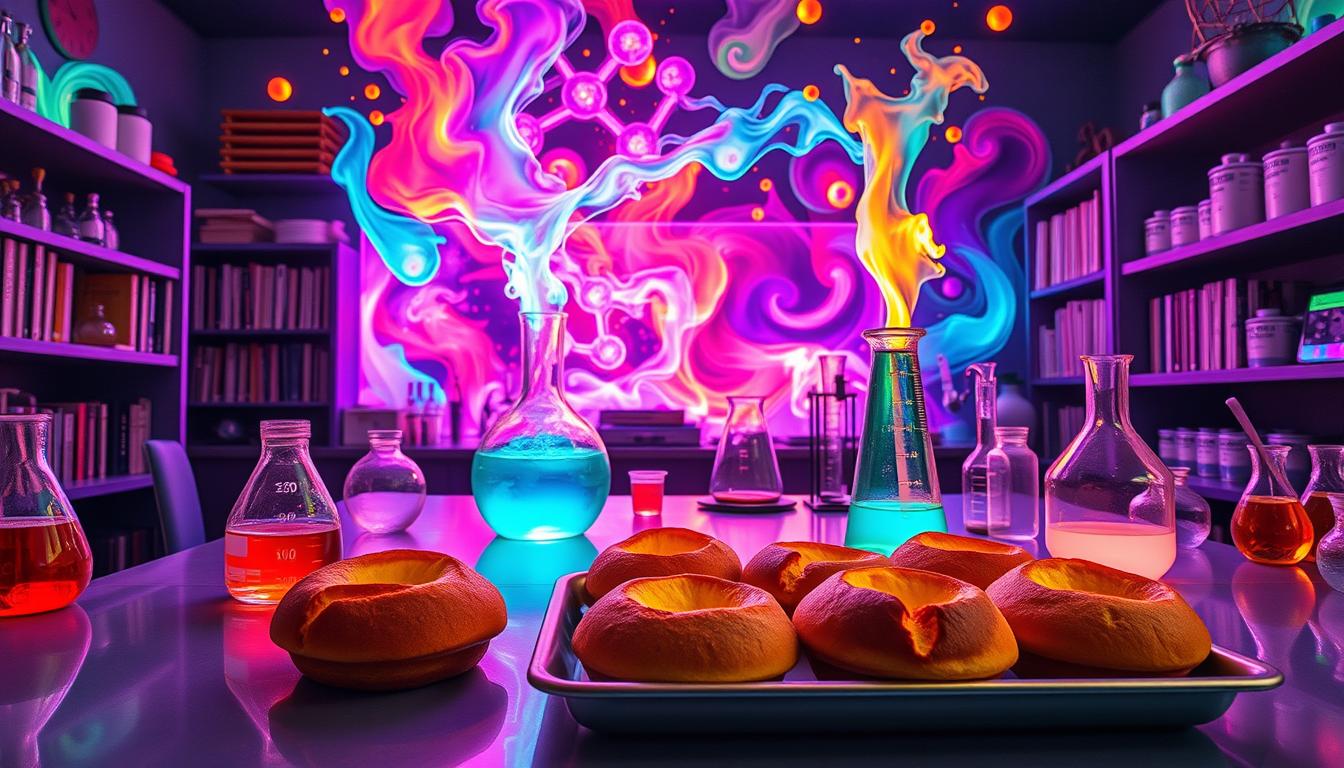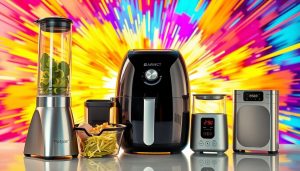Did you know that 90% of baking failures stem from inaccurate measurements or ingredient substitutions? Unlike casual cooking, where improvisation thrives, precise ratios govern everything from bread density to cookie spread. A single extra gram of baking soda can turn muffins bitter, while undermixing batter may collapse a cake’s delicate crumb structure.
Every step in the process relies on predictable chemical reactions. Yeast consumes sugars to release carbon dioxide, creating air pockets in dough. Baking soda activates only when paired with acidic ingredients like yogurt or lemon juice. Even butter’s melting point impacts cookie texture—too warm, and cookies flatten; too cold, and they stay dense.
Professional pastry chefs approach recipes like lab protocols. Temperatures are monitored to the degree, and timing aligns with molecular changes. For example, egg proteins coagulate at specific heat levels, setting custards without curdling. This exactness separates baking from stove-top cooking, where “a pinch of this” rarely derails a dish.
Key Takeaways
- Precision in measurements ensures consistent chemical reactions.
- Ingredient interactions follow strict scientific principles.
- Temperature control directly affects texture and structure.
- Baking relies on predictable molecular behavior.
- Successful results demand methodical techniques over improvisation.
Introduction: Embracing the Science Behind Baking
Your oven hides more secrets than you think. Behind its steel door, ordinary ingredients like flour and sugar transform through heat-driven reactions. Think of your kitchen as humanity’s original lab—a place where edible experiments shape textures and flavors through exact ratios and thermal control.

Discover the Chemical World in Your Oven
When you mix batter, proteins and starches rearrange into elastic networks. Heat then activates reactions: gases expand, sugars caramelize, and fats distribute moisture. Companies like Marky’s Gourmet Foods use this knowledge to engineer pastries with flawless crumb structures. As one food scientist notes, “Timing a bake is like calibrating a lab instrument—every second impacts molecular behavior.”
Connecting Culinary Art with Scientific Precision
Great bakers balance creativity with methodical steps. A cookie’s chewiness depends on butter temperature, while cake rise hinges on protein bonds forming at specific heat. Master these principles, and you’ll troubleshoot collapsed soufflés or dense bread effortlessly. Science turns guesswork into repeatable triumphs.
This fusion of art and accuracy separates casual bakers from pros. Whether adjusting oven zones or swapping acids in recipes, understanding reactions lets you innovate confidently. Your next batch isn’t just food—it’s chemistry in action.
The Science Behind Baking: A Chemical Perspective
Each ingredient in your pantry acts as a chemical agent. When combined under controlled conditions, they trigger reactions that transform batters into airy cakes and dense dough into crusty bread. This process follows rules found in textbooks, not just recipe cards.
Understanding Food Chemistry Fundamentals
Proteins unwind when heated, forming new bonds that give structure to bread. Starches absorb water and swell, creating that familiar soft crumb. Sugars don’t just sweeten—they caramelize, adding complex flavors through thermal decomposition.

“Baking is 90% science and 10% art,” explains pastry researcher Dr. Elena Torres. “Miss one variable, and your entire equation collapses.”
How Heat and Molecules Interact
Your oven acts as a reactor. Trapped gases expand by 5-8% per 18°F temperature increase (Charles’ Law), lifting muffins skyward. Water molecules escape as steam, leaving behind air pockets that define texture.
| Reaction | Chemical Process | Result |
|---|---|---|
| Protein Denaturation | Egg proteins unravel | Structure formation |
| Starch Gelatinization | Granules absorb water | Moist crumb texture |
| Sugar Caramelization | Breakdown at 320°F+ | Complex flavor notes |
| Gas Expansion | CO₂ from yeast | Dough rising |
Notice how cookie spread relates to butter temperature? Cold fat melts slower, delaying sugar dissolution and gas release. Master these interactions, and you control outcomes down to the crumb.
Understanding Food Chemistry in Baking
Your favorite golden-brown crust isn’t just luck—it’s science in action. Three key chemical reactions shape textures and flavors in every batch: Maillard browning, caramelization, and fermentation. Mastering these processes turns simple ingredients into artisanal results.

Essential Reactions: Maillard, Caramelization, and Fermentation
The Maillard reaction creates crusts on bread and cookies when heat triggers amino acids and sugars to combine. This single process generates over 100 flavor compounds—think roasted nuts or freshly baked pie crust.
Caramelization occurs when sugars break down above 320°F. It transforms white sugar into rich notes of butterscotch or toffee. Underbake a tart, and you’ll miss these complex layers.
Fermentation works double duty. Yeast consumes sugars, releasing carbon dioxide for rise and alcohol for nuanced flavors. Sourdough’s tang? That’s lactic acid from slow fermentation.
The Impact of Temperature on Ingredient Behavior
Heat management separates good bakers from great ones. Maillard reactions thrive between 280-330°F—too low, and food stays pale; too high, it burns. Oven thermometers prevent guesswork.
- Butter melts at 92°F: Affects cookie spread and flakiness
- Eggs coagulate at 144°F: Stabilizes cakes and custards
- Yeast dies above 140°F: Kills rise if dough overheats
Track these thresholds, and you’ll control outcomes like a lab technician. Your ingredients become precision tools, not just pantry items.
Roles of Ingredients: Dry and Wet Components in Baking
Every baker’s toolkit contains two armies: dry soldiers and liquid allies. Their teamwork determines whether your cake rises or your cookies crumble. Master their roles, and you’ll turn chaotic mixtures into structured delights.

Dry Ingredients: Architects of Structure
Flour acts as the skeleton. Its gluten proteins form elastic webs that trap gas bubbles during rising. More kneading strengthens these networks—ideal for chewy bread, disastrous for tender cakes.
Sugar isn’t just sweet. It weakens gluten bonds, keeping pastries soft. When creamed with butter, sharp sugar crystals carve air pockets. These holes expand when baking soda reacts, lifting muffins skyward.
| Ingredient | Primary Role | Key Impact |
|---|---|---|
| Flour | Structure formation | Texture (chewy vs. tender) |
| Sugar | Tenderizer & aerator | Sweetness & rise |
| Baking Powder | Gas production | Volume & lightness |
Wet Ingredients: The Binding Force
Eggs multitask. Proteins set structure when heated, while fats add richness. Overmix, and you’ll deflate precious air bubbles. Underbeat, and your cake collapses.
Butter’s temperature dictates outcomes. Cold fat creates flaky layers in pie crusts. Melted butter yields dense brownies. Milk hydrates dry components, ensuring even chemical reactions.
Balance is non-negotiable. Too much flour? Dry bricks. Excess butter? Greasy messes. Measure like a scientist, and your ingredients will collaborate—not compete.
Harnessing Yeast: The Art of Fermentation
That pillowy texture in your sourdough starts with invisible teamwork. Yeast, a wild fungus found on grape skins and in the air, converts flour’s sugars into carbon dioxide and alcohol. This process creates the signature air bubbles and tangy flavors that define artisanal bread.

Creating Air Bubbles and Flavor in Your Bread
Gluten networks act as biological scaffolding. As yeast feeds, gas pockets expand within these protein structures. Cold fermentation (40°F) slows activity, allowing complex flavors to develop over 18-72 hours. Warm environments (75-85°F) accelerate gas production for faster rises.
| Yeast Type | Activation Method | Fermentation Time |
|---|---|---|
| Active Dry | Dissolve in warm water | 60-90 minutes |
| Instant | Mix directly with flour | 45-75 minutes |
| Fresh | Crush into paste | 30-60 minutes |
Overproofing collapses bubbles by stretching gluten too thin. Test readiness by pressing dough—if it springs back halfway, it’s perfectly proofed. As baker Lionel Vatinet notes, “Fermentation isn’t just rising; it’s flavor alchemy.”
Choose yeast wisely. Instant varieties work for quick bread, while sourdough starters excel in slow-fermented loaves. Control temperature and timing, and you’ll transform flour into golden, airy masterpieces.
Baking Reactions: From Maillard to Carbon Dioxide Expansion
Three invisible transformations turn dough into delights: gas expansion, protein networks, and golden crusts. Each stage relies on precise heat management to achieve consistent results. Master these phases, and you’ll control everything from muffin domes to bread’s crackling exterior.

The Chemistry Behind a Perfect Rise
Stage one begins the moment batter hits the oven. Trapped CO₂ bubbles expand rapidly—Charles’ Law in action. This creates lift in cakes and air pockets in bread. Even a 15°F temperature shift alters gas volume by 3%, impacting rise height.
Next, proteins take charge. Egg whites denature at 144°F, forming rigid scaffolds that lock in structure. Gluten strands tighten around expanding gases, preventing collapse. Underbake, and these networks stay weak; overbake, and they turn brittle.
| Stage | Process | Temperature Range | Key Impact |
|---|---|---|---|
| Expansion | CO₂/air bubble growth | 70-212°F | Volume increase |
| Setting | Protein coagulation | 144-180°F | Structure formation |
| Coloring | Maillard reaction | 280-330°F | Flavor & crust |
Final browning occurs through Maillard reactions. Amino acids and sugars combine at high heat, creating 500+ flavor compounds. Pull cookies too early, and you’ll miss their signature caramel notes. As chef Dominique Ansel advises, “Watch the edges, not the clock—science never lies.”
Timing matters most. Open the oven during expansion, and CO₂ escapes, causing sinkholes. Delay removing bread after setting, and moisture evaporates. Track visual cues like crust color and spring-back texture for lab-grade precision.
The Precision Difference: Baking vs Cooking Methods
Your measuring cups hold more power than you realize. While cooking invites spontaneity—a dash of paprika here, an extra garlic clove there—successful pastry work demands lab-grade exactness. A 5% variation in flour amount alters cookie density, and 10 extra minutes of proofing time can collapse a loaf’s structure.
Scientific Accuracy in Baking Measurements
Professional kitchens use digital scales because volume measurements lie. One cup of flour can weigh 120-150 grams depending on humidity and scooping method. This difference impacts gluten development—too much creates tough muffins, too little yields crumbly scones.
| Factor | Cooking Tolerance | Baking Tolerance |
|---|---|---|
| Ingredient Ratios | ±20% acceptable | ±2% max |
| Timing | Flexible intervals | ±3 minute window |
| Temperature | Adjustable mid-process | Exact zones critical |
Environmental factors amplify these challenges. At high altitudes, reduced air pressure requires adjusting leavening agents. Kitchen humidity swells flour before mixing—a detail requiring weight-based adjustments. As pastry chef Claire Saffitz notes: “Baking recipes are blueprints. Deviate without understanding the physics, and the building collapses.”
Mastering this discipline transforms results. When you control variables like water temperature (activates yeast) and oven preheat time (ensures proper rise), recipes become reproducible formulas. Precision turns your countertop into a culinary laboratory where every gram tells a story.
Oven Heat and Its Impact on Baked Goods
Your oven isn’t just an appliance—it’s a precision reactor. Consistent dry heat creates the ideal environment for chemical transformations, turning loose batters into structured treats. Unlike steaming or boiling, this method lets water molecules escape gradually while proteins and starches set permanently.
How Consistent Dry Heat Transforms Your Batter
Heat distribution matters more than you think. A stable 350°F ensures even texture development, from crust formation to crumb structure. Fluctuations disrupt gas expansion rates, leading to lopsided cakes or gummy centers.
Pan size acts as a heat conductor. Metal sheets transfer warmth faster than glass, while dark surfaces absorb more energy. Using a 9-inch pan instead of 8-inch reduces batter depth, accelerating cooking times by 15-20%. Adjust temperatures accordingly.
Steam generation plays dual roles. Early evaporation lifts doughs via gas expansion, while later stages crisp crusts. Control moisture release with parchment lids or water baths for custards. Master these variables, and your oven becomes a tool for edible chemistry.



